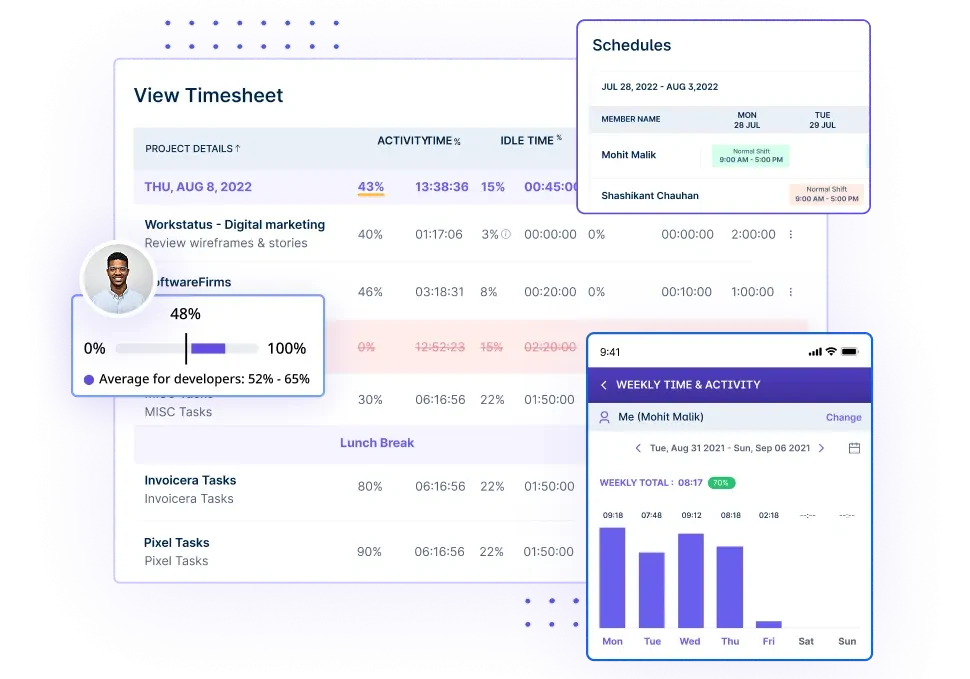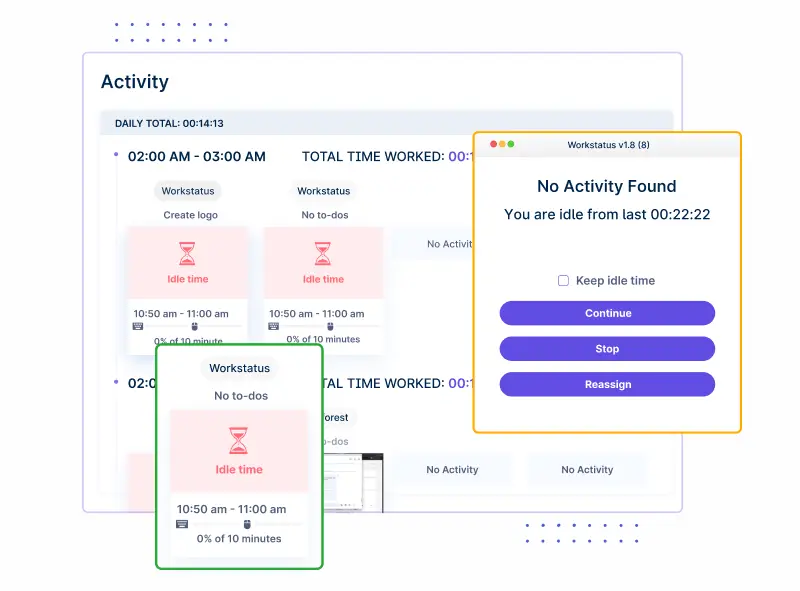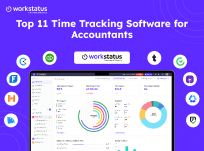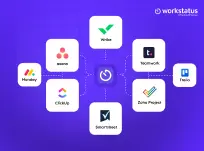Table of Contents
Ever wish you could track your team’s work without constantly checking in?
That’s exactly what time tracking tools do; they let you:
- Track daily hours & timesheets
- Check team productivity
- Manage work easily
In this blog, we’ll show you the Top 11 Business Time Tracking Tools for 2026, what makes them useful, and how they can streamline your operations and workflows.
Let’s dive in!
Common Challenges in Tracking Time Manually
Tracking time by hand can be tricky and messy.
Here’s why:
Forgetting to log hours:
- You can skip tasks or forget entries.
Making mistakes:
- Writing by hand can be messy or wrong.
Hard to see productivity
- You can’t quickly know who is on track.
Too much paperwork
- Filling sheets wastes time.
Late or messy reports
- Getting info for payroll or clients takes longer.
No clear insights
- Hard to know which tasks are a waste of time.
Manual tracking slows your team and causes mistakes. A business time tracking software makes it faster, easier, and more accurate so you can focus on your goals.
Benefits of Employee Time Tracking Software
Employee time tracking apps aren’t just for logging hours; they help teams work smarter, stay accountable, and boost productivity.
Here’s how:
Accurate Timesheets
- No more guessing or manual errors; every hour is tracked.
Stops Time Theft
- Screenshots and geofencing make sure everyone is on task.
See Everything in Real-Time
- Check hours, spot issues, and adjust schedules instantly.
Track Time by Task
- Know which tasks take too long and fix them fast.
Boost Productivity
- Learn from top performers and help everyone work better.
Easy Compliance
- Keep clear records of hours, breaks, and locations.
Smarter Resource Planning
- Balance workloads and schedule the team efficiently.
With time tracking apps, you always know what’s happening, who’s doing what, and how to make every hour count, making your team stronger and your projects smoother.
Top 11 Time Tracking Software for Business Owners
Time tracking software for small businesses help you know what your team is doing, save time, and improve productivity.
Here’s a list of the best apps this year with their key features, USP, and pricing.
1. Workstatus

Workstatus is the best time tracking software for business owners looking to automate timesheets, monitor productivity, and gain complete visibility into team performance.
Key Features:
Automated Timesheets
- Tracks hours automatically; no manual logging.

Productivity & Attendance Reports
- Shows who is working, what, and when.

Idle Time Management
- Finds periods when employees are inactive.

Shift Management
- Plan and track employee shifts easily.

Screen Monitoring
- Screenshots as proof of work and to see work in progress.

USP: All-in-one app for time, attendance, productivity, and shifts. Works great for remote and hybrid teams.
Pricing: Starts from USD 5/user/month
2. TSheets (by QuickBooks)
Key Features:
- Mobile GPS Tracking: Know where employees are while working.
- Geofencing: Clock-in/out automatically at work locations.
- Job Costing: Track hours per project for accurate billing.
- Payroll Integration: Works with QuickBooks and Xero.
USP: Perfect for mobile or field employees.
Pricing: Starts from USD 12/user/month
3. Time Doctor
Key Features:
- App & Web Tracking: Shows what apps and websites employees use.
- Screenshots: Optional images to check work progress.
- Payroll Integration: Easy payroll based on tracked hours.
- Dashboard: Shows employee hours, productivity, and tasks.
USP: Best for remote teams that need accountability.
Pricing: Starts from USD 7/user/month
4. Clockify
Key Features:
- Timers: Track time as you work.
- Timesheets & Reports: Simple reports for payroll and projects.
- Hourly Rates: Calculates costs automatically.
- Integrations: Connects with other tools your team uses.
USP: Free plan available; good for small teams.
Pricing: Starts from USD 5.99/user/month
5. Harvest
Key Features:
- Simple Time Tracking: Easy to log hours.
- Project Budgeting & Billing: Track project costs and billable hours.
- Integrations: Works with apps like Slack, Trello, and QuickBooks.
USP: Great for agencies or teams tracking billable work.
Pricing: Starts from USD 10.8/user/month
6. Deputy
Key Features:
- Shift Scheduling: Plan employee shifts easily.
- Overtime & Alerts: Warns about overtime or schedule conflicts.
- Attendance Tracking: Track who is working and when.
- Compliance: Helps follow labor rules.
USP: Best for shift-based or hourly teams.
Pricing: Starts from USD 4.5/user/month
7. Toggl Track
Key Features:
- Unlimited Users: The Free plan supports any team size.
- Timers & Dashboards: Track hours and tasks easily.
- Productivity Reports: Shows work patterns and efficiency.
USP: Very simple and user-friendly.
Pricing: Free plan available; paid plans start at USD 9/user/month
8. TimeTracko
Key Features:
- Billable Hours Tracking: Track hours for clients/projects.
- Role-Based Access: Control what employees can see.
- Integrations: Works with Trello, Basecamp, and more.
USP: Perfect for teams billing clients by the hour.
Pricing: Contact for pricing
9. InterGuard
Key Features:
- Employee Tracking: Monitors work hours and activity.
- Overtime Calculation: Tracks extra hours automatically.
- Reports: Shows detailed employee productivity.
USP: Great for hourly employees with cloud tracking.
Pricing: Starts from USD 9/user/month
10. DeskTime
Key Features:
- Attendance & Schedule Tracking: Track hours and plan shifts.
- Productivity Tracking: Monitors productive vs. unproductive time.
- Automatic Tracking: Tracks time without manual input.
USP: Good for frontline teams in retail, healthcare, and hospitality.
Pricing: Starts from USD 7/user/month
11. ActiTIME
Key Features:
- Timesheets & Task Tracking: Log hours and tasks easily.
- Billing & Invoicing: Track billable hours and generate invoices.
- QuickBooks Integration: Connects with QuickBooks for payments.
USP: Best for teams who need simple budgeting and billing.
Pricing: Starts from USD 5/user/month
How to Choose The Right Time Tracking Tool?
Picking the right time tracking tool for business can feel tricky. But don’t worry! The right tool saves time, boosts productivity, and keeps your projects on track.
Let’s break it down with some quick tips:
- ✅ Easy to Use: Your team should start tracking in minutes, not hours.
- ✅ Automated Features: Timesheets, idle tracking, and reminders save effort.
- ✅ Track Tasks & Projects: Make sure it links hours to work done.
- ✅ Reports & Insights: Get clear views of productivity and costs.
- ✅ Integrations: Works with payroll, accounting, and project tools.
- ✅ Supports Remote Teams: GPS, geofencing, or cloud access is helpful.
Choose a tool that’s simple, smart, and fits your team, so tracking time is easy and projects stay on budget.
Conclusion
Among these 11 time tracking tools, the choice is yours. We’ve shared the top options; now pick the one that fits your team and business needs best.
The right time tracking tool can save time, boost productivity, and keep your projects on track.
Remember, every team works differently, so choose the tool that makes your workflow easiest and most efficient. Your business, your rules; make time tracking work for you.
FAQs
Ques: What is an employee time tracking tool?
Ans: It is a software that records when employees start and stop work, what tasks they do, and how long they take every day. It helps managers see what the team is working on.
Ques: Why should I use a time tracking tool?
Ans: It helps save time, track productivity, manage projects better, and see real costs clearly. It also makes planning and scheduling much easier.
Ques: Can it work for remote teams?
Ans: Yes! Most tools track work online, use GPS, or show team activity from anywhere, anytime. It keeps remote teams accountable and organized.
Ques: Will it help with payroll and billing?
Ans: Yes! It records hours automatically and can generate accurate reports for payroll and client billing. It reduces mistakes and saves extra work.
Ques: How do I choose the right tool?
Ans: Pick a simple tool, shows tasks and hours clearly, and fits your team’s work style easily. Make sure it matches your team’s size and workflow.












